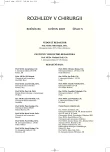Comparison of Various Types of Pharmacological Prevention of Lower Extremities Deep Vein Thrombosis in Patients with Proximal Femoral Fractures
Authors:
S. Trča; Z. Krška; M. Sedlář; Z. Kudrnová *; A. Dohnalová **
Authors‘ workplace:
I. chirurgická klinika VFN a 1. LF UK v Praze, přednosta: doc. MUDr. J. Šváb, CSc.
; Kybernetické oddělení Fyziologického ústavu 1. LF UK, Praha
*; Centrální hematologické laboratoře a trombotické centrum VFN, Praha
*
Published in:
Rozhl. Chir., 2007, roč. 86, č. 5, s. 241-248.
Category:
Monothematic special - Original
Overview
Adminstration of coagulation-active substances is one of the options to prevent thromboemboembolic disease (TED), including deep vein thrombosis and systemic response to stress entailed by an injury or a surgical procedure. Lately, a synthetic analogue of the heparin molecule – of its functionally active part – pentasaccharide (PS), has been developed, among others.
Potential effects of different pharmacopreventive therapies of the deep vein thrombosis was studied in a group of 146 subjects, who suffered proximal femoral fractures and were operated in the Ist Surgical Clinic, VFN Hospital, during 2001–2006. The patients were randomized into 4 different anticoagulant groups (UFH, LMWH, PS short-term and PS long-term). Thromboembolic symptoms, selected postoperative complications and laboratory findings of selected blood count parameters, coagulation, active phase proteins and adhesion molecules, were monitored.
The results indicate existing increased risk of the deep vein thrombosis and a lower rate of the coagulation and fibrinolytic cascade activation, suggesting a higher rate of the hemostatic status stability in the pentasaccharide groups, especially in the groups receiving the long-term pentasaccharide medication (over a month). Therefore, potential pentasaccharide protective effect preventing development of the deep vein thrombosis may be expected.
Key words:
injury – venous thrombosis – pentasaccharide – prevention
Sources
1. Kearon, C. Natural history of venous thromboembolism. Circulation, 2003, Jun, 17, vol. 107 (Supl. 1), s. 122–130.
2. Nicolaides, A. N. Prevention of venousthromboembolism: international konsensus statement: guidelines compiled in accordance with the scientific evidence. Int. Angol., 2001, 20, s. 1–37.
3. Bate, S. M., Ginberg, S. J. Clinical praktice: treatment of deep-vein thrombosis. N. Engl. J. Med., 2004, Jul, 15, vol. 351, s. 268–277.
4. Hyers, T. M. Management of venous thromboembolism: past, prezent and future. Arch. Intern. Med., 2003, Apr, 14, vol. 163, s. 759–768.
5. Geerts, W. H., Pineo, G., Heit, J. A., Bergqvist, D. Prevention of venous thromboembolism. Chest, 2004, 126, Suppl. s. 338S–400S.
6. Jorgensen, P. S., Strandberg, C., Wille-Jorgensen P, et al. Early preoperative thromboprophylaxis with hip fracture surgery: a placebo-controlled study. Clin. Appl. Tromb. Hemost., 1998, 4, s. 140–142.
7. Havig, O. Deep vein thrombosis and pulmonary emboliím: an autopsy study with multiple regression analysis of possible risk factors. Acta Chir. Scand. Suppl., 1977, vol. 478, s. 1–20.
8. Bergqvist, D., Benoni, G., Bjorgell, O., et al. Low-molecular-weight heparin as prophylaxis against venous thromboembolism after total hip replacement. N. Engl. J. Med., 1996, vol. 335, s. 696–700.
9. Larsen, M. R., Bauer, K. A., Ericsson, B. I, et. al. Postoperative fondaparinux versus preoperative enoxaparin for prezent of venous thromboembolism in elective hip-replacement surgery: a randomised dooouble-blind comparison. The Lancet, 2002, May, 18, vol. 351, s. 1715–1720.
10. Ericsson, B. I., Bauer, K. A., Larsen, M. R., Turpie A. G. Fondaparinux compared with enoxaparin for the prevention of venous thromboembolism after hip-fracture surgery. N. Engl. J. Med., 2001, November, 1, No. 18, vol. 345, s. 1298–1304.
11. Ericsson, B. I., Larsen, M. R., et al. Durativ of prophylaxis against venous thromboembolism with fondaparinux after hip-fracture surgery. Arch. Intern. Med., 2003, vol. 163, s. 1337–1342.
12. Robinson, D. M., Wellington, K. Fondaparinux sodium. A review its use in the treatment of acute venous thromboembolism. Am. J. Cardiovasc., 2005, 5, s. 335–346.
13. Bříza, J., Kudrna, K., Kvasnička, J., Bušta, O, Trča, S. Reakce akutní fáze u těžkých úrazů. In: Sborník lékařský, roč. 103, č. 2, 2002, s. 193–202, 1LF.
14. Kvasnička, J., Bříza, J., Krška, Z., Kudrna, K., Pešková, M., Pecen, L. Zvýšení rozpuštěných cytoadhesivních molekul E-selektinu a ICAM-l a hyperfibrinogenemie u pacientů s polytraumatem bez septikemie. In: Sborník lékařský, roč. 99, č. 2, 1998, s. 93–96, 1LF.
15. Krška, Z., Trča, S., Šváb, J. Profylaxe žilní trombózy v chirurgii – začátky, dnešní stav, ACCP konsensus, výhled. Rozhl. Chir., 2006, roč. 85, č. 6, s. 302–310.
16. Penka, M., Buliková, A., Matýšková, M., Zavřelová, J. Diseminovaná intravaskulární koagulace. Praha: Grada, 1. vyd., 2003, s. 85.
17. Šiller J., Havlíček K. Pooperační plicní infekční komplikace – význam výživy a imunitního systému. Experimentální část. SK Chir., 2005; 2, s. 10–12.
Labels
Surgery Orthopaedics Trauma surgeryArticle was published in
Perspectives in Surgery

2007 Issue 5
Most read in this issue
- Current Trends of the Treatment of the Femoral Neck Fractures in Seniors
- Application of the Targon PH Long Nail in Storey Fractures and Metaphyseal Fractures of the Proximal Humerus
- Vertebral Body Replacement with a Synex Implant
- Tactical and Technical Notes for Decompression Surgery – a Review
